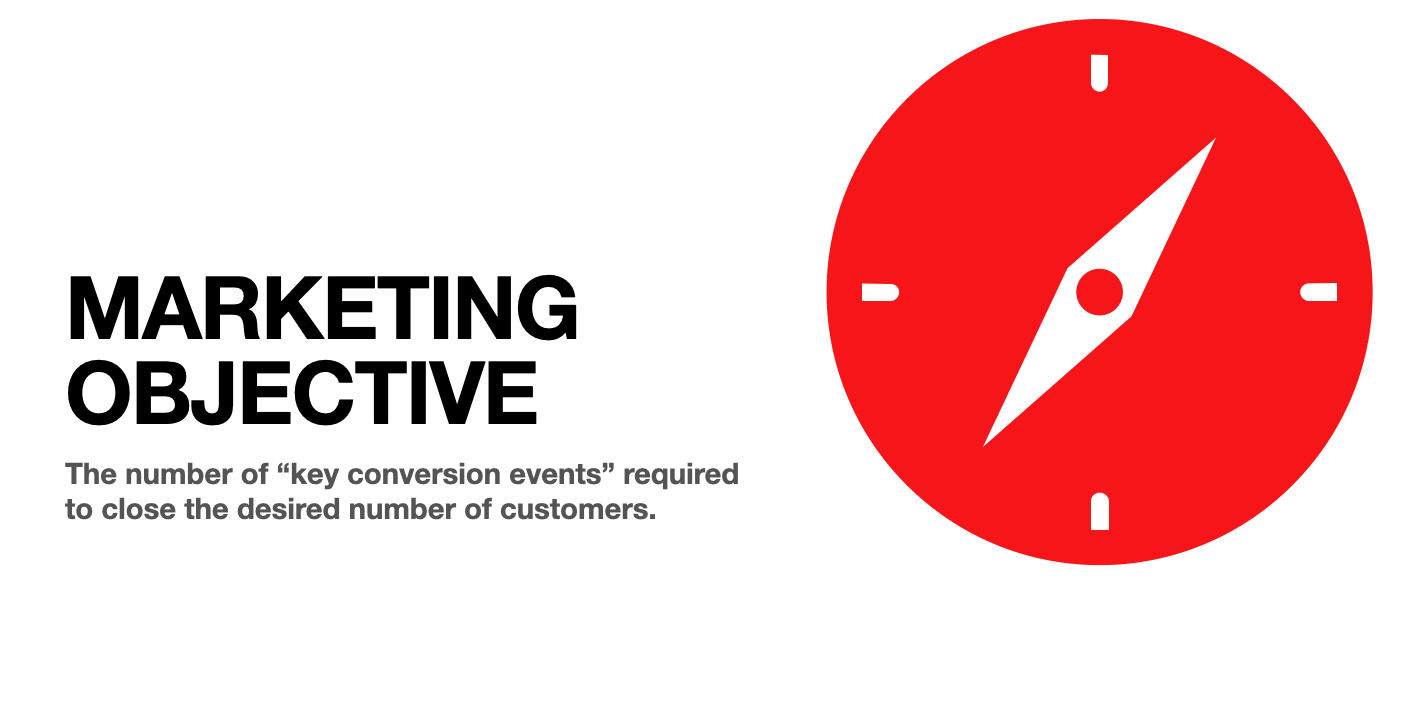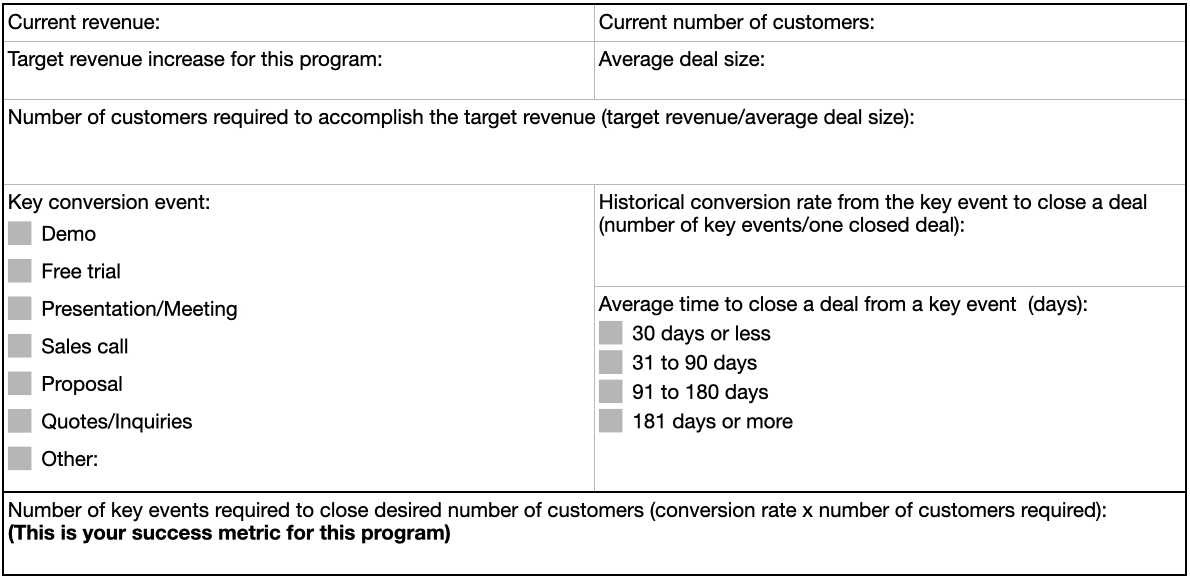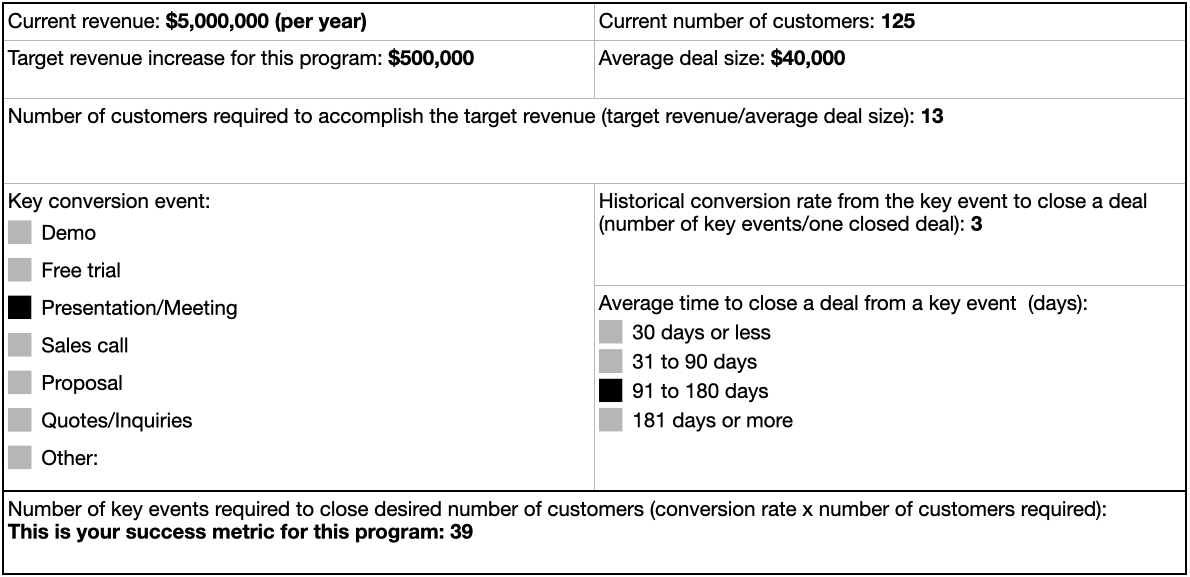As marketers, we all know and value the importance of setting SMART goals for our marketing campaigns. In practice, though, defining an effective marketing objective for a lead generation campaign is not always a trivial task.
Many business goals do meet the SMART criteria (e.g., Increase revenue by 15% within the next 12 months), but it’s not quite clear what’s the right way to translate these business goals into lead gen campaign objectives.
In this post, I am going to introduce a practical approach that will help you set a SMARTer marketing goal for your next lead gen campaign.
How to set an effective marketing objective
First, we need to have a clear definition of a Lead Gen Marketing Objective. Here’s the one I’ve found most helpful:
The number of “key conversion events” required to close the desired number of customers.

Looking at this definition, you’re probably thinking: What are those “key conversion events”? How do we know the desired number of customers to close?
Let me explain with an example:
Let’s say we are an agency starting to work with a new client who has defined the following business goal:
Increase revenue by 15% within the next 12 months
To translate this into a campaign objective, we use the following worksheet:
And here are the steps to set an effective marketing objective for this campaign:
Current revenue
Note that this the total annual revenue of the company. For this client, the total revenue is $5,000,000/year.
The current number of customers
Suppose this hypothetical client primarily sells to businesses and currently has 125 customers that generate the $5 million annual revenue mentioned above.
Target revenue increase for this program
At first glance, you might think the target revenue increase is $750,000 (15% x $5,000,000), but that’s not correct. Because the revenue increase will rarely come through only one lead gen program. Most companies have multiple ways to generate revenue. Here are a few examples:
- Business Development: Salespeople who find and reach out to prospects, directly.
- Account Management: Account Executives who expand an existing client.
- Referral Programs: Where growth comes from word-of-mouth, organically.
Several other sources can contribute to the revenue growth objective. To set up a realistic marketing objective, we’d work closely with the client to define how much of the overall growth can be expected to come from this lead gen campaign.
We look at historical data to find patterns for all existing sources and deduct the identified sources from the total revenue increase goal. In our example, the client determines that they can expect:
- $150,000 in revenue growth from existing accounts.
- $100,000 additional revenue from 2 new trade shows that they plan to exhibit at this coming year.
Now we can more accurately calculate the target revenue for our campaign by deducting those from the total revenue increase goal: $750,000 - $150,000 - $100,000 = $500,000.
Average deal size
Averages can be misleading, so be careful with your assumptions here. In our example, if the client has several products/services with a wide range of pricing, we’d want to know if they have a preference to market specific product(s) or service(s) and would adjust our calculations accordingly.
To keep things simple, we assume our client has only one product. The average deal size can be calculated by dividing the total revenue by the number of customers they currently have: $5,000,000 / 125 = $40,000
Number of customers required to accomplish the target revenue
Now that we have clearly defined the target revenue for this campaign and an accurate measure of deal size, we can easily calculate the number of customers we need to hit the target:
Number of new customers required = target revenue/average deal size
In our example: $500,000/$40,000 = 12.5, which we round it up to 13 new customers.
Key conversion event
I believe this is the most important concept of this goal-setting framework, so if you don’t get anything out of this approach, I hope you at least take this one point away.
What do we mean by a key conversion event?
For most businesses, there’s usually one crucial step that has to happen before a deal is closed. Here are a few examples:
- For a SaaS company, the key conversion event can be a free trial or a demo sign up.
- For a senior living community, this can be a scheduling a tour of their facility.
- For a web design firm, it can be a request for a proposal.
- For a manufacturing company, it can be asking for a quote.
For our client, the key conversion event is booking a 1:1 meeting with the sales team.
Why is this so important? Most lead gen campaigns fail because the objective is defined by the number of “leads” generated. Which leads marketers to focus on ‘the number of eBook downloads’ or ‘newsletter sign-ups’ or other metrics that are not directly tied to the desired business outcome (in this case, revenue growth driven by acquiring new customers).
That’s why you need to clearly define a single key conversion event and set your marketing objective based on that.
Historical conversion rate
Now that we know a 1:1 meeting is a required step to close a deal, we ask our client:
How many meetings do you usually have to have to close a new customer?
The answer to this question determines your conversion rate. You need to look at the historical data to ensure the ratio is correct.
In our example, our client confirmed that they usually get one new customer from every three meetings that they have.
Average time to close a deal from a key event
This step is not required to set the marketing objective. It’s useful to know ‘when’ the campaign goals are expected to be achieved. Longer sales cycles mean that you need to be more patient and monitor early indicators more closely.
In our example, the client knows that after a 1:1 meeting, it usually takes between 91 to 180 days to close a new deal. It’s expected that two months into the campaign, we probably haven’t won a new customer yet.
Set the marketing campaign objective
The objective is now can be set:
Number of key events required to close the desired number of customers = historical conversion rate x number of customers required
For our example, our lead gen campaign objective is to set up 39 (3 x 13) booked meetings within six months (to allow 180 days to close after the meeting).
Here’s the completed worksheet for our example:
Is your marketing objective SMART?
Our objective is specific and measurable. We also know that it is relevant and time-bound. But is it achievable?
Here’s how you can answer this question:
Look at the historical data:
How many 1:1 meetings has the company had last month? Last quarter? Last year? Does having 39 meetings within six months seem reasonable? Is it too low or too high?
If the number doesn’t seem reasonable, go back to the worksheet, reassess your assumptions, and answer the questions again.
Check the target audience size:
To have a successful lead gen campaign, you are going to have a clearly defined target audience. The size of the audience and the response rate of your campaign will determine whether or not your marketing objective is achievable. Here’s how:
Number of key events = target audience size x campaign response rate
So once you know the size of your audience, you need to calculate the response rate. Note that the response here is based on the definition of your key conversion event. Our key event is to schedule 1:1 meetings if someone only downloads a white paper without booking a meeting, that is not considered a response.
While there’s no scientific formula to calculate the response rate of a marketing campaign, here are a few benchmarks that can help you arrive at a sensible estimate:
- Minimum: If you have a reasonable offer and have picked the right audience, your campaign should at least yield a 0.5% response rate.
- Target: The response rate of a successful lead gen campaign is typically around 3%. This rate is what you should aim for.
- Optimal: Some campaigns have a higher response rate. A 5% response rate is quite possible, and I have had a few campaigns with two-digit response rates.
Back to our example: If we pick 3% as our target response rate, in order to have 39 meetings scheduled, our target audience should at least have 1300 (39/0.03) contacts.
If the client has fewer contacts in their target list, we may need to revisit the objective. Luckily the client has confirmed they have a list of 2000 quality contacts, so we are in good shape!
Whether you are setting a goal for your company or your client, this goal-setting approach gives you (and your client) a clear success metric for your lead gen campaign.
What do you think?
Do you have any questions or comments? Ping me on twitter @RaminZamani
Enjoyed the read?
Don't miss the next one! Subscribe now:
Thank you! Please check your email to confirm your subscription!
Cover photo by Samuel Clara on Unsplash